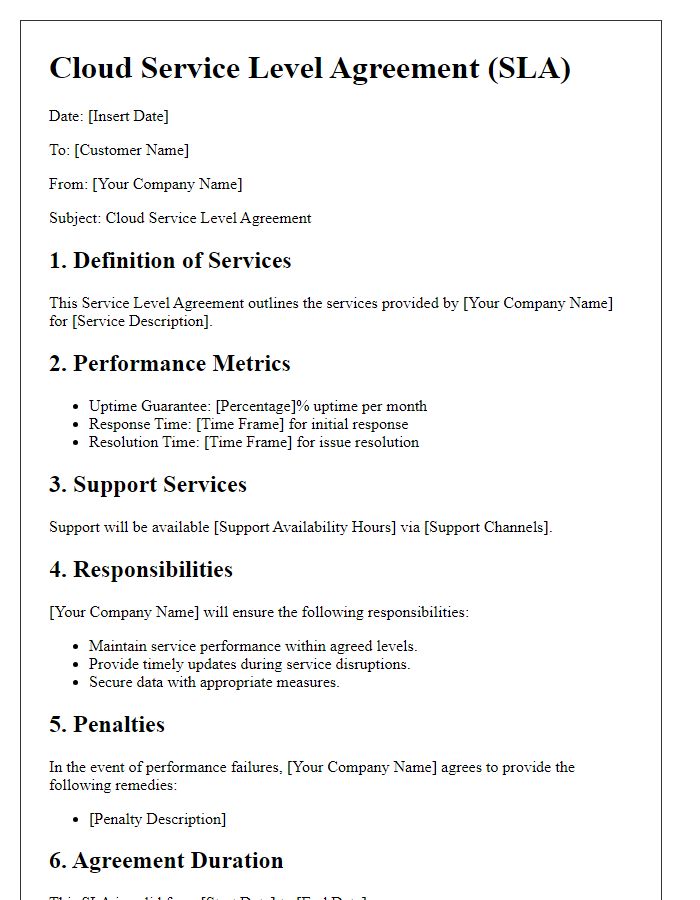Are you considering venturing into the world of cloud computing? Navigating the complexities of agreements can be daunting, but having a solid template is essential for any successful partnership. By outlining key terms and conditions, a well-crafted cloud computing agreement can provide clarity and protection for both parties involved. Dive deeper into how to create an effective agreement by reading more!

Parties Involved and Contact Information
A cloud computing agreement typically includes key parties involved in the agreement, such as service providers and clients, along with their detailed contact information. The service provider, for example, Amazon Web Services (AWS), may be represented by a legal team located in Seattle, Washington, with contact numbers like +1-206-555-0199. The client, represented by a business in New York, might have their contact emails and addresses listed, ensuring clear communication. Including specific roles such as 'Service Provider Representative' or 'Client Point of Contact' with designated phone numbers reinforces accountability. Accurate identification of both parties establishes clarity and strengthens the contractual relationship.
Scope of Services and Deliverables
The cloud computing agreement outlines a comprehensive scope of services and deliverables that includes Infrastructure as a Service (IaaS), Platform as a Service (PaaS), and Software as a Service (SaaS) options. The deliverables consist of a virtual machine setup with specific configurations, storage solutions with scalability options, and database management systems compatible with various operating systems. Service level agreements (SLAs) define uptime metrics, typically targeting at least 99.9% availability and support response times under 1 hour for critical issues. Data protection strategies include automated backups occurring daily, encryption standards exceeding AES 256-bit, and disaster recovery plans ensuring data integrity and availability with recovery time objectives (RTOs) and recovery point objectives (RPOs) clearly specified. Compliance with regulatory frameworks such as GDPR and HIPAA guarantees that sensitive data remains secure in the cloud environment.
Service Level Agreement (SLA) and Performance Metrics
Cloud computing agreements often include a Service Level Agreement (SLA) that outlines the expectations regarding service availability, response times, and performance metrics. SLAs typically specify uptime guarantees (e.g., 99.9% uptime per month) and define critical incidents, ensuring support response times (e.g., within one hour for critical issues). Performance metrics assess the efficiency and effectiveness of cloud services, measuring aspects like data transfer speeds (e.g., average of 100 Mbps) and latency (e.g., less than 20 milliseconds). Additionally, the agreement may include compensation clauses detailing service credits (e.g., 5% discount on monthly fees for every hour of downtime beyond agreed limits), providing assurance to clients about service reliability and performance adherence. Definitions of maintenance windows and communication protocols for outages further ensure transparency and trust between cloud service providers and clients.
Data Security, Privacy, and Compliance
Cloud computing agreements regarding data security, privacy, and compliance involve intricate regulations and best practices. Data processing services, like those provided by Amazon Web Services (AWS) or Microsoft Azure, require adherence to standards such as GDPR (General Data Protection Regulation) and HIPAA (Health Insurance Portability and Accountability Act) to ensure user data remains protected. Organizations must implement encryption protocols, such as AES (Advanced Encryption Standard), for data stored in the cloud and during transit. Regular audits and assessments, as mandated by compliance frameworks like PCI DSS (Payment Card Industry Data Security Standard), are necessary to maintain standards and protect sensitive information. Additionally, retention policies must clearly outline the duration data will be stored and the procedures in place for its deletion to ensure compliance with local laws.
Payment Terms and Billing Structure
Payment terms for cloud computing agreements typically include monthly billing cycles, with fees based on resource usage, storage capacity, or service tiers. Billing structures may feature subscription models (e.g., pay-as-you-go or flat-rate pricing) and often include additional charges for overages beyond allocated resources. Discounts for annual commitments might also be offered, incentivizing long-term usage. Invoicing schedules can vary, ranging from upfront payments to post-service billing, ensuring clarity in payment expectations. Additionally, payment methods (e.g., credit cards, bank transfers) must be specified, along with any applicable taxes or late payment penalties, ensuring transparent financial transactions.













Comments